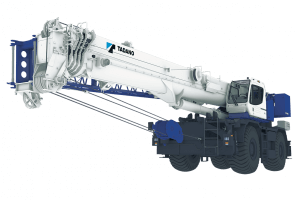
Tadano has released internationally, a new line of next generation rough terrains, designed to increase safety, comfort, performance and with the latest engine technology, reduce emissions – meeting the latest environmental standards.
Tadano Oceania will launch three models into the Australian market over this year including the GR-1000EX-4, GR-900EX-4, and GR-700EX-4. These models mark a full model upgrade of the rough terrain cranes in the 70t to 100t lifting class.
Tadano’s rough terrain cranes are flagship products for the company and lead the global rough terrain market. The new next-generation rough terrain models feature improved lifting capacity to meet the demands of a growing market.
The GR-1000EX-4: Developed as Tadano’s first model for the international rough terrain market and has a lifting capacity of 100t. The multi-telescoping cylinder boom features a 51m boom which is the longest boom in its class. It has a gross vehicle weight of 45t for easy transportability.
The GR-900EX-4 is a newly developed 90t lifting capacity model. The GR-900EX-4 is a highly competitive product, even among its own class.
The GR-700EX-4: With a 70t lifting capacity this model features a 47m boom, again the longest in its class. It has an allrounder stronger chart making it one of the most versatile and well-balanced rough terrain cranes in the industry.
The cab design and fittings have been remodelled to improve work efficiency, operability, and visibility. The new and large, multi-function colour touch panel display is 26cms in size and contains crane work information and operation settings which will help to increase work efficiency. The panel display is also pressure-sensitive, so it can be operated while using gloves.
The cab instrument panel shape, height, and angle of the glass face have also been modified, improving visibility from the driver’s seat. The new models also use the 20-degree cab tilt function which helps to reduce operator fatigue when operating the crane for long periods of time.
The GR-1000EX-4 is the first Tadano rough terrain to feature the “Smart Counterweight” system, which enables the counterweight to have two mounting positions. This feature provides improved stability which can increase by up to 22%.
Tadano has also incorporated the proprietary “Smart Chart” enabling work performance to be maximised from the crane.
Other technology on board includes the Tadano View System, as well as a winch drum monitoring camera that checks the winding state of the wire rope when the crane is in operation. Cameras are on the right-front and rear of the crane to aid visibility while driving.
The newly developed pump disconnect function automatically stops operation of the crane’s hydraulic pump if the crane is not operated for a certain period of time, contributing to a reduction in fuel consumption. The models are also equipped with functions such as the Fuel Monitoring System, Eco-Mode, and Positive Control that support environmentally friendly operations by reducing CO2 emissions, improving fuel consumption, and reducing noise.
Tadano’s Hello-Net telematics information service is included as a standard feature. This function ascertains the crane’s operation status using mobile and satellite communications and supports the checking of positional information via GPS and maintenance information on a website. The new models also feature six speed transmission powered by a Mitsubishi 6M60-TLU3R engine generating 200kw (267HP).
According to Anthony Grosser, Managing Director Tadano Oceania, the new models set new standards for the rough terrain market.
“As the leader in the rough terrain market, Tadano is constantly evolving the product to deliver an unparalleled user experience. With the heavy demand in Australia for rough terrains, particularly with the significant increase in activity within the mining and construction sectors, these new models will continue to outperform in the harshest of working environments. We are proud to lead the next evolution of rough terrains into the future,” said Grosser.
